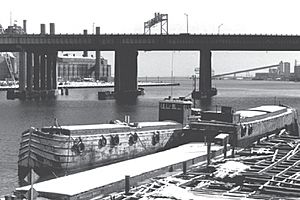Elmer S. Dailey facts for kids

1973 image of the three barges; Elmer S. Dailey is the rightmost
|
|
| History | |
|---|---|
| Owner | Steward J. Dailey |
| Operator | S. J. Dailey Company |
| Route | Connecticut–Long Island Sound |
| Builder | William H. Follette |
| Completed | 1915 |
| Out of service | 1974 |
| Fate | Sunk in 1974 |
| General characteristics | |
| Type | Canal barge |
| Tonnage | 101 |
| Length | 105.2 feet (32.1 m) |
| Beam | 17.9 feet (5.5 m) |
| Depth of hold | 9.9 feet (3.0 m) |
| Propulsion | Fairbanks-Morse diesel engines |
|
Elmer S. Dailey
|
|
| Location | Bridgeport Harbor, Bridgeport, Connecticut |
| Area | less than one acre |
| Built | 1935 |
| Architect | Follette, William H. |
| NRHP reference No. | 78002837 |
| Added to NRHP | December 21, 1978 |
The Elmer S. Dailey is a special old wooden boat called a barge. It was first built in 1915 and was named the Claire B. Follette. Later, in 1928, it was rebuilt and got its new name. This barge was used to carry goods like sand or gravel between places in New York, New Jersey, and Connecticut.
The Elmer S. Dailey is very important because it's the only known Erie Canal boat still around. It's also one of the few remaining canal boats made of wood. In 1974, it sank in the harbor of Bridgeport, Connecticut, along with two other barges. Because it's so old and has been underwater for a long time, it's now very fragile. The Elmer S. Dailey was added to the National Register of Historic Places in 1978.
What the Elmer S. Dailey Looks Like
The Elmer S. Dailey is a type of boat made for the Erie Canal. It has two powerful Fairbanks-Morse diesel engines. The barge is about 105.2 feet (32.1 m) long. That's longer than two school buses! It is also about 17.9 feet (5.5 m) wide. The part of the boat that holds cargo is about 9.9 feet (3.0 m) deep. It could carry up to 101 tons of materials.
The boat has a shape that is almost like a rectangle. Both the front (bow) and back (stern) are a bit rounded. The sides of the boat, called bulwarks, have small holes to let water drain out. There are also strong wooden strips along the sides.
A raised edge, about 2 feet (0.61 m) high, goes around the large opening where cargo was loaded. This opening takes up about two-thirds of the boat's length. It was covered by curved hatch covers. Towards the back of the boat, there's a rectangular room for the pilot (pilothouse). There's also a small cabin with a doorway and a tall smokestack.
The History of the Elmer S. Dailey
The Elmer S. Dailey started its life in 1915. It was built by William H. Follette in Tonawanda (city), New York. Back then, it was called the Claire B. Follette.
In 1928, the boat was rebuilt by a company called Brown Drydock on Staten Island. That's when it got its new name, Elmer S. Dailey. During this rebuilding, Brown Drydock added two Fairbanks-Morse diesel engines. They also added the pilothouse and the smokestack. Later, one of the engines was removed. A different engine, powered by compressed air, was put in its place. When it was working, the boat usually had a crew of three people.
The owner of the ship was Stewart J. Dailey. He used to be a mule driver on the Erie Canal. Later, he became a partner in a shipbuilding company. He then started his own business, the S. J. Dailey Company.
The barge was used to move materials between ports in New York, New Jersey, and Connecticut. After the diesel engines were added, it was strong enough to push another barge. The Elmer S. Dailey was actively working from 1941 to 1972. After that, it was tied up in Bridgeport, Connecticut Harbor. It was moored with two other barges, the Berkshire No. 7 and the Priscilla Dailey.
In the spring of 1974, one of these barges started to fill with water. As it sank, it pulled the other two barges down with it. Now, no part of the Elmer S. Dailey can be seen above the water.
Why the Elmer S. Dailey is Important
The Elmer S. Dailey is very important for history. It is the only known surviving boat that was used on the Erie Canal. It's also one of the few remaining canal boats that were built with a wooden hull. Because of its historical value, it was added to the National Register of Historic Places on December 21, 1978. The Elmer S. Dailey and the two other barges that sank with it are the only shipwrecks in Connecticut that are listed on the National Register of Historic Places.
In 1998, the sunken barges caused some concern for the Port Authority of Bridgeport Harbor. They were in the way of a big project to redevelop the harbor. Over the years, the barges have become very fragile. If someone tried to pull them out of the water, they would likely break apart.
By 2003, no action had been taken to move the barges. However, a report suggested that before anything is done with the Elmer S. Dailey, it should be fully documented. This means taking photos and writing a detailed description of the barge. These important records would then be kept at the State Historic Preservation Office and the Mystic Seaport Museum.



